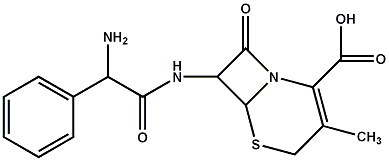To the Editor: Moran et al. write, "In areas with a high prevalence of CA-MRSA [community acquired methicillin-resistant Staphylococcus aureus], empiric treatment for skin and soft tissue infections (SSTIs) with [beta]-lactam agents such as cephalexin may no longer be appropriate. Oral agents such as clindamycin or trimethoprim/sul famethoxazole and rifampin should be considered in CA-MRSA" (1). However, some studies have had different results. Lee et al. reported that 31 (84%) of 37 Texas children with CA-MRSA SSTIs showed clinical improvement after incision and drainage, even though they received an "ineffective" antimicrobial agent that was not changed after the susceptibility results became available (2). These researchers also reviewed some reports with similar experience in the United States and further suggested that incision and drainage without adjunctive antimicrobial therapy were effective in immunocompetent children for CA-MRSA SSTIs <5 cm in diameter.
Several studies on Taiwanese children with CA-MRSA SSTIs agree with the viewpoint of Lee et al. Chen and colleagues reported that 22 (63%) of 35 episodes of CA-MRSA superficial soft tissue infections in children were cured by nonsusceptible antimicrobial therapy, regardless of surgical intervention (3). In a study by Wang et al., oxacillin, with or without incision and drainage, was effective in 16 (89%) of 18 children with CA-MRSA SSTIs, even in a case with high-level oxacillin resistance (MIC [greater than or equal to] 8 [micro]g/mL) (4). Fang et al. also reported that 16 (55%) of 29 children with CA-MRSA SSTIs were eventually cured with therapy to which their infections were not susceptible (5). With these experiences and concerns about the growing problem of bacterial resistance, we suggest that incision and drainage, with or without adjunctive antimicrobial therapy, are adequate to treat noninvasive CA-MRSA SSTIs in immunocompetent children and that oxacillin or first-generation cephalosporins are still effective and sufficient under such conditions. Vancomycin and other agents that are effective against MRSA isolates should be reserved for invasive CA-MRSA infections or for immunocompromised patients. Although Moran's study was focused on adults, not on children as these studies were, we believe these suggestions are also appropriate when applied to CA-MRSA SSTIs in adults.
Finally, the antibiogram of CA-MRSA isolates may vary from country to country. In Taiwan, CA-MRSA isolates are also resistant to multiple antimicrobial agents; 71.4%, 91.4%, and 41.2% are resistant to clindamycin, erythromycin, and chloramphenicol, respectively (4). Trimethoprim/ sulfamethoxazole is more effective against CA-MRSA isolates than other first-line antimicrobial agents: the resistance rate is 0%-65.7% (4,5). Therefore, clindamycin and trimethoprim/sulfamethoxazole may be not adequate empiric antimicrobial agents for SSTIs in Taiwan or other areas with a high prevalence of CA-MRSA.
Jui-Shan Ma *
* Show-ChwanMemorial Hospital, Changhua, Taiwan
References
(1.) Moran GJ, Amii RN, Abrahamian FM, Talan DA. Methicillin-resistant Staphylococcus aureus in community-acquired skin infections. Emerg Infect Dis. 2005;11: 928-30.
(2.) Lee MC, Rios AM, Aten MF, Mejias A, Cavuoti D, McCracken GH Jr, et al. Management and outcome of children with skin and soft tissue abscesses caused by community-acquired methicillin-resistant Staphylococcus aureus. Pediatr Infect Dis J. 2004;23:123-7.
(3.) Chen CJ, Huang YC, Chiu CH, Su LH, Lin TY. Clinical features and genotyping analysis of community-acquired methicillin-resistant Staphylococcus aureus infections in Taiwanese children. Pediatr Infect Dis J. 2005;24:40-5.
(4.) Wang CC, Lo WT, Chu ML, Siu LK. Epidemiological typing of community-acquired methicillin-resistant Staphylococcus aureus isolates from children in Taiwan. Clin Infect Dis. 2004;39:481-7.
(5.) Fang YH, Hsueh PR, Hu JJ, Lee PI, Chen JM, Lee CY, et al. Community-acquired methicillin-resistant Staphylococcus aureus in children in northern Taiwan. J Microbiol Immunol Infect. 2004;37:29-34.
Address for correspondence: Jui-Shan Ma, 542, Sec 1, Chung-Shang Rd, Changhua, 500 Taiwan; fax: 886-4-723-6226; email: morrison@show.org.tw
In response: Dr Ma makes an excellent point about the limitations of study data on antimicrobial drug treatment of skin abscesses (1). All of the patients described in our study (2) required antimicrobial drug therapy, and most were admitted to the hospital. However, we did not mean to imply that all skin abscesses require antimicrobial drug treatment. Our own practice is to give antimicrobial drug therapy only when a skin abscess is associated with definite surrounding cellulitis, systemic signs, or both. Although various criteria have been published, in practice this is a judgment call, and we suspect that physicians vary considerably in use of antimicrobial agents for skin infections.
Because most cellulitis associated with skin abscess will improve with adequate drainage, designing a study that will find a difference in outcome attributable to the antimicrobial drug is difficult. More studies are needed to determine whether antimicrobial agents with in vitro activity against methicillin-resistant Staphylococcus aureus (MRSA) are more clinically effective than those lacking such activity. Perhaps these studies should focus on those infections for which antimicrobial agents would be expected to have the greatest impact (e.g., infected wounds with cellulitis), rather than abscesses that can be expected to improve with incision and drainage alone.
When the decision is made to use an antimicrobial agent, it is difficult to justify choosing one to which the infecting organism will likely be resistant. Because MRSA is now the most common cause of skin infections at our institution, we choose agents with activity against the MRSA strains in our community. We do not believe that choosing an antimicrobial agent to which the infecting organism is susceptible is more likely to contribute to the general problem of antimicrobial drug resistance.
Gregory J. Moran, * Ricky N. Amii, * Frederick M. Abrahamian,* and David A. Talan *
* Olive View-UCLA Medical Center, Sylmar, California, USA
References
(1.) Ma J-S. Methicillin-resistant Staphylococcus aureus skin infections [letter]. Emerg Infect Dis. 2005; 11:1644-5.
(2.) Moran GJ, Amii RN, Abrahamian FM, Talan DA. Methicillin-resistant Staphylococcus aureus in community-acquired skin infections. Emerg Infect Dis. 2005;11:928-30.
Address for correspondence: Gregory J. Moran, Olive View-UCLA, Emergency Medicine, 14445 Olive View Dr, Sylmar, CA 91342, USA; fax: 818-364-3268; email: gmoran@ ucla.edu
COPYRIGHT 2005 U.S. National Center for Infectious Diseases
COPYRIGHT 2005 Gale Group


